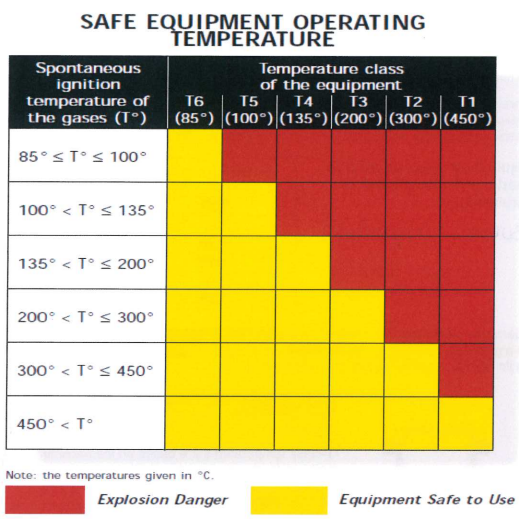Equipment Group #
In the IEC system, electrical equipment for explosive atmosphere is divided into groups. The group allocation for surface and mining industries are separate.
Group I is reserved for the mining industry (hazards are ‘firedamp’ & coal dust)
Group II is for surface industries with gas hazards, and is subdivided into IIA, IIB and IIC
Typical gases: propane, ethylene, and hydrogen
Group III is for surface industries with dust hazards, subdivided into IIIA, IIIB and IIIC
Flyings, non-conductive dusts, and conductive dusts
This course deals with Group II
The equipment group or sub-division will be marked on the equipment nameplate:
Equipment marked just II may be used in all hazards.
Equipment marked IIA can only be used in IIA hazards.
Equipment marked IIB can be used in IIB and IIA hazards.
Equipment marked IIC can be used in all hazards.
Equipment marked II(XXX) is only for used in XXX (chemical formula / hazard name).
Temperature Classification: T Class #
Equipment is classified of into one of six temperature classes, from 85°C up to 450°C.
Electrical equipment must be selected to ensure that the surface temperature produced by the equipment (indicated by the ‘T’ Class) will not exceed the ignition temperature of the flammable atmosphere which may be present around the equipment.
Equipment temperature class making (‘T’ Class) and its equivalent °C. #
| Temperature Class | Maximum Surface Temperature |
| T1 | 450°C |
| T2 | 300°C |
| T3 | 200°C |
| T4 | 135°C |
| T5 | 100°C |
| T6 | 85°C |
Temperature classification is based on the maximum temperature which any relevant part of the equipment, which may be in contact with an explosive gas can reach, when operated within its normal designed rating and maximum ambient.
Ambient temperature range for Ex equipment is -20°C to +40°C, unless otherwise marked on the equipment.
T-class temperatures are based on the maximum ambient for the equipment, and this is the temperature that must be used in any temperature rise calculations.
The equipment ambient rating must be compatible with the actual environment ambient temperature.
Equipment for use in hot climates, such as the Middle Eastern countries, will usually require ambient ratings greater than 40°C. Equipment for use in colder (arctic) climates will require a much lower limit to the ambient temperature range, which may be as low as -50°C.
Such equipment would need special materials and expensive testing for certification.
In the table, for each material, the equipment T class is seen to be below the ignition temperature of the flammable material.
| Material | Group | Ignition Temperature °C | Required T- Class °C |
| Hydrogen | IIC | 560 | T1 (450) |
| Acetylene | IIC | 305 | T2 (300) |
| Carbon Disulphide | IIC | 90 | T6 (85) |
| Ethylene | IIB | 440 | T2 (300) |
| Hydrogen Sulphide | IIB | 260 | T3 (200) |
| Diethyl Ether | IIB | 175 | T4 (135) |
| Propane | IIA | 450 | T2 (300) |
| Cyclohexane | IIA | 244 | T3 (200) |
| Benzaldehyde | IIA | 192 | T4 (135) |
| Methane (firedamp) | I | 595 | T1 (450) |
Note: Equipment Group and T-Class are not directly related.

Table of ignition temperature vs. required equipment T-class #
| Ignition Temperature of the mixture in the area is within the range for: | Equipment T-class which may be used |
| T1 | T1, T2, T3, T4, T5, T6 |
| T2 | T2, T3, T4, T5, T6 |
| T3 | T3, T4, T5, T6 |
| T4 | T4, T5, T6 |
| T5 | T5, T6 |
| T6 | T6 |




